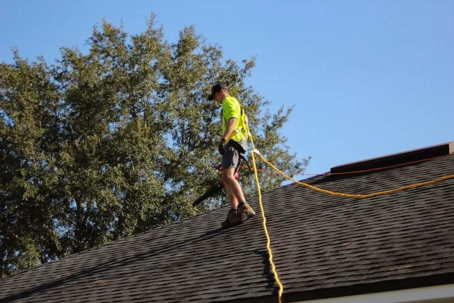What is a Roofing Square?
Find Out What Is the Roofing Square and What Its Used For
If you’re planning a roofing project and it’s time to order materials, you may have heard the term “roofing square” thrown around. Understanding what a roofing square is and why it's used will help you make sense of your inventory needs, your final bill, and the reason there may be excess materials at the end of your project.
A roofing square is a unit of measurement used in the construction industry. It is equal to 100 square feet (9.29m2). Roofing squares are used to measure the area of a roof and are also used to estimate the amount of material needed to cover a roof.
Roofing squares are also used to calculate the amount of material needed to cover a roof. Most roofs are covered with asphalt shingles which are sold by the square. One square of shingles will cover 100 square feet (9.29m2) of roof surface, however, the measurement is the same for roof underlayment, metal roofing, and other materials.
Who Uses Roofing Squares?
Roofing squares are mainly used by roofers, but they are also used by general contractors, home builders, and remodelers. Homeowners may use them when estimating the cost of a roofing project or when buying materials for a do-it-yourself project.
How Much Does A Square Of Roofing Cost?
The cost of a roofing square will vary depending on the type of material used and the region where the project is taking place. Asphalt shingles are the most common type of roofing material and they usually cost between $100 and $200 per square. Metal roofing, slate, and tile are more expensive materials and can cost between $300 and $1,000 per square.
Factors That Determine The Cost Of A Roofing Square
- The type of roofing material
- The size of the roof
- The pitch or slope of the roof
- The complexity of the roof design
- The region where the project is taking place
How Do I Calculate The Size Of My Roof In Squares?
Calculating the size of your roof in squares is not as simple as it may seem, especially because most homeowners aren’t dealing with a flat roof. This job is best left up to a contractor, but if you need an estimate or are in a pinch, this guide will give you the general steps of the process.
1. Find The Square Footage Of Your Roof
It is important to note that the square footage of a roof is not always equal to the number of roofing squares. This is because the edge of the roof is not always a square shape. When calculating the number of squares needed it is best to measure the length and width of the roof in feet and multiply them together. This will give you the square footage of the roof.
For example, a roof that is 30 feet long and 40 feet wide would have the square footage of 1,200 (30x40). This roof would require 12 squares of shingles or other roofing material on a flat rectangular roof.
2. Consider The Slope Of Your Roof
The next step is to consider the slope or pitch of your roof. The pitch is the angle of the roof and is measured by the rise over run. The rise is the vertical distance from the peak of the roof to the eaves and the run is the horizontal distance from the eave to the ridge. The slope is the angle of the roof and is measured by the number of inches the roof rises for every 12 inches it extends.
For example, a roof with a 4/12 slope rises 4 inches for every 12 inches it extends.
The most common pitches used in residential construction are 4/12, 5/12, and 6/12. This means that for every 12 inches (305mm) of horizontal distance there is a 4 inch (102mm), 5 inch (127mm), or 6-inch (152mm) vertical rise.
Pitches can also be expressed as a ratio such as 1:12 or 2:12. Once you estimate the pitch of your roof, you can use a pitch multiplier table to find the actual number of squares your roof will require.
For example, a 4/12 roof will require 1.16 squares per 100 square feet (9.29m2). This is because the slope of the roof makes it larger than a flat roof.
3. Remember 1 Square Is Not Always 100 Square Feet
When laying roofing materials like shingles, there will be something called "headlap" to account for. Headlap is the amount of material that overlaps between squares to adequately cover a roof. The amount of headlap will depend on the manufacturer's recommendation and the type of roofing material being used.
For example, a common headlap for asphalt shingles is 4 inches (102mm). This means that for every 12 inches (305mm) of horizontal distance there is a 4-inch (102mm) overlap. A roofing square will include the amount of material necessary to cover 100 square feet of the roof.
4. Use A Multiplying Factor To Find The Number Of Squares
If you are working with a complex roof, you will need to use a multiplying factor to find the number of squares. A complex roof is one that has dormers, valleys, hips, or other factors that make it difficult to estimate the number of squares.
For example, if you have a roof with two dormers, you will use a multiplying factor of 1.4 to find the number of squares. This is because the dormers make the roof more complex and require more material to account for waste or the parts of a roofing square that must be cut to fit the roof shape.
Conclusion
Roofing squares are a quick and easy way for roofers to estimate the amount of material they need without spending hours on calculations. Deciding the number of roofing materials you'll need to complete a project is best left to the professionals, but it is still good for homeowners to know what a roofing square is and how it factors into the budget for your roof project.
If you're planning a roofing project, make sure to consult with a professional roofing contractor to get an accurate estimate of the number and type of materials you'll need.


